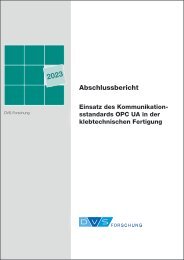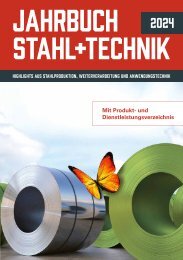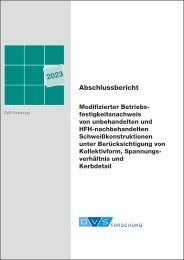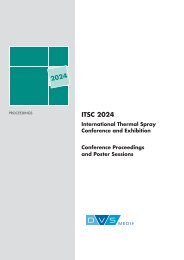Sie wollen auch ein ePaper? Erhöhen Sie die Reichweite Ihrer Titel.
YUMPU macht aus Druck-PDFs automatisch weboptimierte ePaper, die Google liebt.
element diameter in Equation 2-5 with the dimension of each side. This yields one short near field<br />
and long near field distance. The actual near field length of a rectangular virtual probe aperture is<br />
somewhere between these two values.<br />
Near field length of a circular element:<br />
Figure 2-7: Diagram of sound field<br />
zones<br />
N = D 2 * F/4C Equation 2-5<br />
N = Near-field length<br />
D = Element Diameter<br />
F = Frequency<br />
C = Material Velocity<br />
When considering the propagation of sound through a medium, some assumptions are made.<br />
Assumptions are necessary to predict the direction and velocity of propagation as well as the<br />
intensity of sound at any point in the medium and how it interacts with discontinuities. A short<br />
discussion about these assumptions is presented here before the more general discussion on sound<br />
beam characteristics.<br />
Ray tracing is a standard method of modeling the way sound propagates through isotropic media,<br />
which involves first order approximations to determine the sound field characteristics. These<br />
assumptions are reasonable in the far field when considering isotropic materials. Within this<br />
assumption, the sound is treated as a ray that is reflected or refracted by the interfaces it<br />
encounters. The grain structure is considered isotropic and does not affect the sound beam. The<br />
sound is also assumed to have no intensity variation across the pressure front. There is no<br />
distinction between the near field and the far field within this assumption.<br />
In reality, the propagation of sound is far more complex, and includes diffraction and nonlinear<br />
effects. Sound beams are better approximated by Gaussian equations, which have far different<br />
behavior in the near field (or Fresnel zone) than in the far field (or Fraunhofer zone). They also<br />
have a nonlinear intensity profile in a direction perpendicular to the direction of beam travel.<br />
Using beam mapping, one can determine the area of maximum amplitude, which is typically<br />
within the centre of the beam. Amplitude decreases as the perimeter of the beam is approached,<br />
but the function is not linear as assumed in many ultrasonic applications. At any particular cross<br />
section within the beam, energy density is not constant. This is seen in Figure 2-8 where the<br />
intensity of a sound beam is shown as colour. In the top series of figures, the cross section of the<br />
9


















